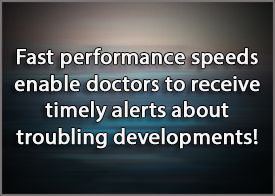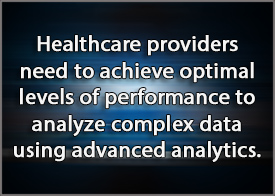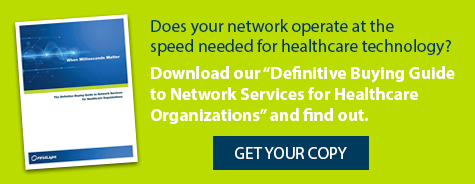
Speed is crucial in healthcare. After a traumatic injury, stroke, or heart attack, a medical team has a small window in which to stabilize and treat a patient to produce the best outcome. For example, the National Stroke Association emphasizes that getting medical help immediately after a stroke is the key to optimal recovery, noting that drug treatment should be administered within 3 hours.
As healthcare organizations increasingly rely on wireless technology to communicate and share data, they need faster Internet with greater bandwidth. The State of Clinical Communication & Workflow study found that 51% of healthcare providers have plans to implement smartphones as communication devices across their organization.
The healthcare industry creates unique performance challenges for the network. Large volumes of complex data need to travel rapidly across distances so patients can be treated in a timely manner. Consequently, healthcare providers need to support their technology with a high-speed fiber optic network.
Going the Distance
 Healthcare organizations need to share data across locations and entities to provide optimal patient care. Initial treatment of injuries may occur in the field after an accident or a natural disaster. EMTs must communicate with doctors at the main hospital or medical center.
Healthcare organizations need to share data across locations and entities to provide optimal patient care. Initial treatment of injuries may occur in the field after an accident or a natural disaster. EMTs must communicate with doctors at the main hospital or medical center.
Frequently, healthcare is a collaborative process, requiring that members of a treatment team transmit information back and forth between departments. In some cases, a doctor may need to consult with a specialist at another hospital or even gain assistance during an operation from a surgeon hundreds of miles away.
Healthcare providers use mobile devices to extend their reach and give patients greater access to treatment. mHealth, the use of mobile devices to connect patients and doctors, can be used to make diagnoses remotely through video chats.
Wearables provide data about vital signs so doctors can track trends in heart rate, blood pressure, and blood sugar levels. Fast performance speeds enable doctors to receive timely alerts about troubling developments.
Going for Speed
None of these innovations in healthcare are possible without the ability to send medical information quickly. Healthcare providers must use real-time data to make diagnoses and treatment decisions.
A patient’s condition can change quickly after a traumatic event. An injured person may be responsive initially, but take a turn for the worse moments later.
When EMTs are in the field, they can’t afford to wait for information about a patient’s medical history. They need to know about additional risk factors, such as allergies and chronic conditions, as soon as possible. The medical team back at the hospital also relies on current information about a patient’s condition to offer the correct advice.
Too Much Information
 Transmitting medical information quickly can be a challenge because of the variety and complexity of data that must be shared. Healthcare providers need to transmit unstructured data in the form of imaging scans and doctors’ notes.
Transmitting medical information quickly can be a challenge because of the variety and complexity of data that must be shared. Healthcare providers need to transmit unstructured data in the form of imaging scans and doctors’ notes.
Huge volumes of patient data are required to make diagnoses and treatment decisions. Necessary data could mean a patient’s entire medical history.
Healthcare providers need to achieve optimal levels of performance to analyze this complex data using advanced analytics. Artificial intelligence (AI) is being used to analyze MRIs, CT scans, X-rays, and even tissue samples. AI has the power to conduct virtual biopsies or find signs of tuberculosis in a patient’s X-ray.
Built for Speed
The demands of healthcare technology put a huge burden on the network. A high-speed, low-latency fiber optic network is up to the challenge. Fibers the width of a human hair allow data to travel at the speed of light. With fiber, huge volumes of information can be sent more quickly and efficiently than traditional networks.
When a network provider combines fiber optics with encrypted wavelength, healthcare providers gain security without sacrificing performance speed.
FirstLight is experienced at providing high-speed network services for healthcare organizations in the Northeast. We understand HIPAA compliance and have enhanced our network offerings with encrypted wavelength. Encrypted wavelength protects data in transit while maintaining low latency rates so patient data can be transmitted at lightning speeds.
Does your network operate at the speed needed for healthcare technology? Download our “Definitive Buying Guide to Network Services for Healthcare Organizations” and find out.





















